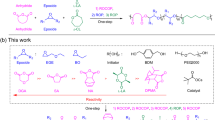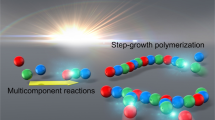Abstract
With its focus on synthetic reactions that are highly specific and reliable, ‘click’ chemistry has become a valuable tool for many scientific research areas and applications. Combining the modular, covalently bonded nature of click-chemistry linkages with an ability to reverse these linkages and reuse the constituent reactants in another click reaction, however, is a feature that is not found in most click reactions. Here we show that triazolinedione compounds can be used in click-chemistry applications. We present examples of simple and ultrafast macromolecular functionalization, polymer–polymer linking and polymer crosslinking under ambient conditions without the need for a catalyst. Moreover, when triazolinediones are combined with indole reaction partners, the reverse reaction can also be induced at elevated temperatures, and the triazolinedione reacted with a different reaction partner, reversibly or irreversibly dependent on its exact nature. We have used this ‘transclick’ reaction to introduce thermoreversible links into polyurethane and polymethacrylate materials, which allows dynamic polymer-network healing, reshaping and recycling.
This is a preview of subscription content, access via your institution
Access options
Subscribe to this journal
Receive 12 print issues and online access
$259.00 per year
only $21.58 per issue
Buy this article
- Purchase on Springer Link
- Instant access to full article PDF
Prices may be subject to local taxes which are calculated during checkout






Similar content being viewed by others
Change history
11 August 2014
Technical issues with our online publication processes resulted in this Article being published the day after that referred to in the print version. The official date of publication is 11 August 2014.
References
Kolb, H. C., Finn, M. G. & Sharpless, K. B. Click chemistry: diverse chemical function from a few good reactions. Angew. Chem. Int. Ed. 40, 2004–2021 (2001).
Moses, J. E. & Moorhouse, A. D. The growing applications of click chemistry. Chem. Soc. Rev. 36, 1249–1262 (2007).
Xi, W., Scott, T. F., Kloxin, C. J. & Bowman, C. N. Click chemistry in materials science. Adv. Funct. Mater. 24, 2572–2590 (2014).
Golas, P. L. & Matyjaszewski, K. Marrying click chemistry with polymerization: expanding the scope of polymeric materials. Chem. Soc. Rev. 39, 1338–1354 (2010).
Tasdelen, M. A. & Yagci, Y. Light-induced click reactions. Angew. Chem. Int. Ed. 52, 5930–5938 (2013).
Pauloehrl, T. et al. Adding spatial control to click chemistry: phototriggered Diels–Alder surface (bio)functionalization at ambient temperature. Angew. Chem. Int. Ed. 51, 1071–1074 (2012).
Barner-Kowollik, C. et al. ‘Clicking' polymers or just efficient linking: what is the difference? Angew. Chem. Int. Ed. 50, 60–62 (2011).
Tasdelen, M. A. Diels–Alder ‘click' reactions: recent applications in polymer and material science. Polym. Chem. 2, 2133–2145 (2011).
Mather, B. D., Viswanathan, K., Miller, K. M. & Long, T. E. Michael addition reactions in macromolecular design for emerging technologies. Prog. Polym. Sci. 31, 487–531 (2006).
Cookson, R. C., Gilani, S. S. H. & Stevens, I. D. R. 4-Phenyl-1,2,4-triazolin-3,5-dione: a powerful dienophile. Tetrahedron Lett. 3, 615–618 (1962).
Radl S. in Advances in Heterocyclic Chemistry Vol. 67 (ed. Katritzky, A. R.) 119–208 (Elsevier, 1997).
Funel, J-A. & Abele, S. Industrial applications of the Diels–Alder reaction. Angew. Chem. Int. Ed. 52, 3822–3863 (2013).
Nicolaou, K. C., Snyder, S. A., Montagnon, T. & Vassilikogiannakis, G. The Diels–Alder reaction in total synthesis. Angew. Chem. Int. Ed. 41, 1668–1698 (2002).
Novikov, R. A., Korolev, V. A. & Tomilov, Y. V. Reactions of 4-phenyl-1,2,4-triazoline-3,5-dione with 2-pyrazolines. Russ. Chem. Bull. 60, 1685–1693 (2011).
Gillis B. T. & Hagarty J. D. The reaction of 4-phenyl-1,2,4-triazoline-3,5-dione with conjugated dienes. J. Org. Chem. 32, 330–333 (1966).
Syrgiannis, Z., Koutsianopoulos, F., Muir, K. W. & Elemes, Y. Reaction of a triazolinedione with simple alkenes. Isolation and characterization of hydration products. Tetrahedron Lett. 50, 277–280 (2009).
Korobitsyna, I. K., Khalikova, A. V., Rodina, L. L. & Shusherina, N. P. 4-Phenyl-1,2,4-triazoline-3,5-dione in organic synthesis (review). Chem. Heterocycl. Compd 19, 117–136 (1983).
Jensen, F. & Foote, C. S. Reaction of 4-phenyl-1,2,4-triazoline-3,5-dione with substituted butadienes. A nonconcerted Diels–Alder reaction. J. Am. Chem. Soc. 109, 6376–6385 (1987).
Higashi, T., Shibayama, Y., Fuji, M. & Shimada, K. Liquid chromatography–tandem mass spectrometric method for the determination of salivary 25-hydroxyvitamin D3: a noninvasive tool for the assessment of vitamin D status. Anal. Bioanal. Chem. 391, 229–238 (2008).
Aronov, P. A., Hall, L. M., Dettmer, K., Stephensen, C. B. & Hammock, B. D. Metabolic profiling of major vitamin D metabolites using Diels–Alder derivatization and ultra-performance liquid chromatography–tandem mass spectrometry. Anal. Bioanal. Chem. 391, 1917–1930 (2008).
Hoogewijs, K., Buyst, D., Winne, J. M., Martins, J. C. & Madder, A. Exploiting furan's versatile reactivity in reversible and irreversible orthogonal peptide labeling. Chem. Commun. 49, 2927–2929 (2013).
Ban, H., Gavrilyuk, J. & Barbas, C. F. Tyrosine bioconjugation through aqueous ene-type reactions: a click-like reaction for tyrosine. J. Am. Chem. Soc. 132, 1523–1525 (2010).
Ban, H. et al. Facile and stabile linkages through tyrosine: bioconjugation strategies with the tyrosine-click reaction. Bioconjugate Chem. 24, 520–532 (2013).
Pieken, W. et al. Method for solution phase synthesis of oligonucleotides. World patent WO98/47910 (1998).
Chen, T. C. S. & Butler, G. B. Chemical reactions on polymers. 111. Modification of diene polymers via the ene reaction with 4-substituted-1,2,4-triazoline-3,5-diones. J. Macromol. Sci. Pure Appl. Chem. 16, 757–768 (1981).
Butler, G. B. Triazolinedione modified polydienes. Ind. Eng. Chem. Prod. Res. Dev. 19, 512–528 (1980).
Kaufmann, T. et al. ‘Sandwich' microcontact printing as a mild route towards monodisperse Janus particles with tailored bifunctionality. Adv. Mater. 23, 79–83 (2011).
Espeel, P. et al. Multifunctionalized sequence-defined oligomers from a single building block. Angew. Chem. Int. Ed. 125, 13503–13506 (2013).
Stamenovic, M. M. et al. Straightforward synthesis of functionalized cyclic polymers in high yield via RAFT and thiolactone–disulfide chemistry. Polym. Chem. 4, 184–193 (2013).
Hansell, C. F. et al. Additive-free clicking for polymer functionalization and coupling by tetrazine–norbornene chemistry. J. Am. Chem. Soc. 133, 13828–13831 (2011).
Kricheldorf H. R. & Denchev Z. in Transreactions in Condensation Polymers (ed. Favirov, S.) Ch. 8, 319–389 (Wiley-VCH, 1999).
Collins, K. D. & Glorius, F. A robustness screen for the rapid assessment of chemical reactions. Nature Chem. 5, 597–601 (2013).
Rickborn, B. The retro-Diels–Alder reaction Part II. Dienophiles with one or more heteroatom (Organic Reactions 53, John Wiley, 2004).
Baran, P. S., Guerrero, C. A. & Corey, E. J. The first method for protection-deprotection of the indole 2,3-π bond. Org. Lett. 5, 1999–2001 (2003).
Zweifel H., Maier R. D. & Schiller M. Plastics Additives Handbook (Hanser, 2009).
Inglis, A. J., Paulöhrl, T. & Barner-Kowollik, C. Ambient temperature synthesis of a versatile macromolecular building block: cyclopentadienyl-capped polymers. Macromolecules 43, 33–36 (2009).
Acknowledgements
B. De Meyer is acknowledged for the measurements of the LC-SEC samples. S.B. and F.D. thank the Agency for Innovation by Science and Technology in Flanders for PhD scholarships. K.D.B. thanks the Research Foundation-Flanders (FWO) for the funding of his fellowship. H.G., F.D.P. and V.V.S. acknowledge the FWO (Vlaanderen), the Research Board of Ghent University and the Belgian Science Policy Office Interuniversity Attraction Poles (IAP) programme in the frame of IAP 7/05 for financial support. Computational resources and services used in this work were provided by Ghent University (Stevin Supercomputer Infrastructure).
Author information
Authors and Affiliations
Contributions
S.B, K.D.B., F.D. and H.G. performed the experiments. S.B., K.D.B., J.M.W. and F.D.P. conceived and designed the experiments. H.G. and V.V.S. were responsible for the theoretical calculations. S.B., J.M.W. and F.D.P wrote the paper. K.D.B prepared all the figures. All the authors discussed the results and commented on the manuscript at all stages.
Corresponding authors
Ethics declarations
Competing interests
The authors declare no competing financial interests.
Supplementary information
Supplementary information
Supplementary information (PDF 17324 kb)
Supplementary movie 1
Supplementary movie 1 (MP4 5325 kb)
Supplementary movie 2
Supplementary movie 2 (MP4 7789 kb)
Rights and permissions
About this article
Cite this article
Billiet, S., De Bruycker, K., Driessen, F. et al. Triazolinediones enable ultrafast and reversible click chemistry for the design of dynamic polymer systems. Nature Chem 6, 815–821 (2014). https://doi.org/10.1038/nchem.2023
Received:
Accepted:
Published:
Issue Date:
DOI: https://doi.org/10.1038/nchem.2023
This article is cited by
-
Photoswitchable dynamic conjugate addition-elimination reactions as a tool for light-mediated click and clip chemistry
Nature Communications (2023)
-
Closed-loop chemical recycling of cross-linked polymeric materials based on reversible amidation chemistry
Nature Communications (2022)
-
Force–reversible chemical reaction at ambient temperature for designing toughened dynamic covalent polymer networks
Nature Communications (2022)
-
Upcycling of dynamic thiourea thermoset polymers by intrinsic chemical strengthening
Nature Communications (2022)
-
Functional polymer materials based on dynamic covalent chemistry
Science China Materials (2022)



